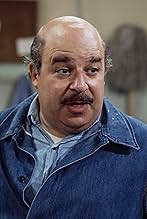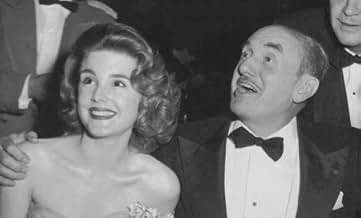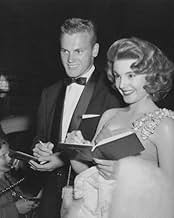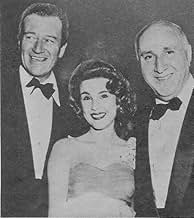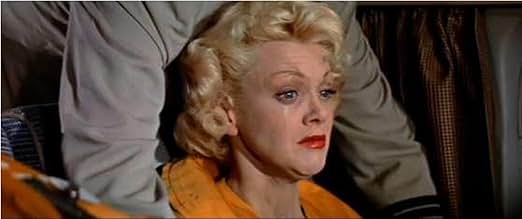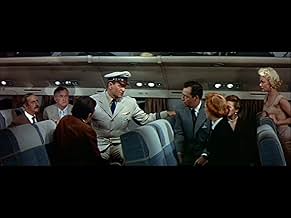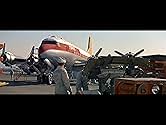PUNTUACIÓN EN IMDb
6,6/10
6,9 mil
TU PUNTUACIÓN
Cuando un avión comercial desarrolla problemas de motor en un vuelo transpacífico y el piloto pierde los nervios, depende del copiloto Dan Roman llevar el avión a salvo.Cuando un avión comercial desarrolla problemas de motor en un vuelo transpacífico y el piloto pierde los nervios, depende del copiloto Dan Roman llevar el avión a salvo.Cuando un avión comercial desarrolla problemas de motor en un vuelo transpacífico y el piloto pierde los nervios, depende del copiloto Dan Roman llevar el avión a salvo.
- Ganó 1 premio Óscar
- 5 premios y 7 nominaciones en total
Pedro Gonzalez Gonzalez
- Gonzales
- (as Gonzalez Gonzalez)
Reseñas destacadas
"The High and the Mighty", the granddaddy of air disaster movies, often falls into almost campy melodrama, but under the direction of the legendary 'Wild Bill' Wellman, and punctuated by one of Dimitri Tiomkin's most bombastic yet exciting scores (earning him an Oscar), the film maintains such a level of intensity that it remains constantly entertaining. With John Wayne heading an ensemble cast (including several co-stars from the past, as well as personal friends), it is certainly an essential for any 'Duke' film library.
Produced by Wayne-Fellows Productions, and 'owned', eventually, by the Wayne family's Batjac Productions (along with "Hondo", "McLintock!", and "Island in the Sky"), the film was a BIG hit, when released, and offered one of Wayne's better performances, then gained even greater stature as it was unseen for a generation. I've always held the belief that the family planned to release the entire quartet of films in 2007, to mark the centennial of Duke's birth, but two events changed the plan; first, an unauthorized, 'remixed' VHS version of "McLintock!" was released, with rumors that a version of "Hondo" was also in the works, forcing Michael Wayne, then President of Batjac, to release authorized VHS versions of the two films, rather than have the market glutted with bad copies; second, with Michael's death, in 2003, the Wayne family rethought the master plan, deciding to release the entire collection on DVD earlier. For whatever reason, seeing "The High and the Mighty" again is a cause to celebrate!
Based on Ernest K. Gann's bestseller (which would inspire Arthur Hailey's later novel, "Airport"), the story centers around a routine commercial flight between Honolulu and San Francisco, which becomes a life-and-death drama when one engine explodes, just beyond the 'Point of No Return'. With limited fuel, in deteriorating weather, the crisis brings out the best and worst in both passengers and crew.
Wayne as the co-pilot, is quite good, playing a character older than he actually was (the role had been written for Spencer Tracy, who pulled out, just prior to filming); Robert Stack almost foreshadows his character in "Airplane!" as the no-nonsense pilot who goes ballistic when stressed. For cockpit 'overacting', however, the award has to go to Wally Brown, as the navigator, with his bugged-out eyes, visions of his shrewish wife, and WILDLY unruly hair...
While the passengers are all stereotypes, several actors are quite good in their roles, with standout performances by Claire Trevor and Jan Sterling (both Oscar-nominated), Robert Newton, Paul Kelly, and Paul Fix. While Phil Harris attempts to inject humor into his role, it only works sporadically (and Ann Doran, as his wife, plays 'hysterical' so convincingly that you want to STRANGLE her!) Laraine Day, third-billed (and, with Trevor, a previous Wayne leading lady), is remarkably unlikable as a rich wife with a 'bought' husband (John Howard); Sidney Blackmer plays the 'mandatory' unbalanced type; and veteran character actor John Qualen adds another 'ethnic' portrayal to his long list, as a Latin family man (with a Norwegian accent!) A bit of trivia: The young boy on board was portrayed by director Wellman's son!
Almost as fascinating as the story is seeing how much has changed, since the film was released; the plane's 'tail' is controlled by pulleys and wires in a rear compartment; the sole flight attendant is a "stewardess"; and everyone smokes (especially in the cockpit). On a more somber note, there is NO security, and one passenger boards easily, carrying a gun. It is, sadly, a wiser world, today...
While no one would ever accuse "The High and the Mighty" of being a film classic, it's role in creating the 'airplane disaster' genre can't be denied, and it continues to be a vastly enjoyable John Wayne feature.
It's great to have it back!
Produced by Wayne-Fellows Productions, and 'owned', eventually, by the Wayne family's Batjac Productions (along with "Hondo", "McLintock!", and "Island in the Sky"), the film was a BIG hit, when released, and offered one of Wayne's better performances, then gained even greater stature as it was unseen for a generation. I've always held the belief that the family planned to release the entire quartet of films in 2007, to mark the centennial of Duke's birth, but two events changed the plan; first, an unauthorized, 'remixed' VHS version of "McLintock!" was released, with rumors that a version of "Hondo" was also in the works, forcing Michael Wayne, then President of Batjac, to release authorized VHS versions of the two films, rather than have the market glutted with bad copies; second, with Michael's death, in 2003, the Wayne family rethought the master plan, deciding to release the entire collection on DVD earlier. For whatever reason, seeing "The High and the Mighty" again is a cause to celebrate!
Based on Ernest K. Gann's bestseller (which would inspire Arthur Hailey's later novel, "Airport"), the story centers around a routine commercial flight between Honolulu and San Francisco, which becomes a life-and-death drama when one engine explodes, just beyond the 'Point of No Return'. With limited fuel, in deteriorating weather, the crisis brings out the best and worst in both passengers and crew.
Wayne as the co-pilot, is quite good, playing a character older than he actually was (the role had been written for Spencer Tracy, who pulled out, just prior to filming); Robert Stack almost foreshadows his character in "Airplane!" as the no-nonsense pilot who goes ballistic when stressed. For cockpit 'overacting', however, the award has to go to Wally Brown, as the navigator, with his bugged-out eyes, visions of his shrewish wife, and WILDLY unruly hair...
While the passengers are all stereotypes, several actors are quite good in their roles, with standout performances by Claire Trevor and Jan Sterling (both Oscar-nominated), Robert Newton, Paul Kelly, and Paul Fix. While Phil Harris attempts to inject humor into his role, it only works sporadically (and Ann Doran, as his wife, plays 'hysterical' so convincingly that you want to STRANGLE her!) Laraine Day, third-billed (and, with Trevor, a previous Wayne leading lady), is remarkably unlikable as a rich wife with a 'bought' husband (John Howard); Sidney Blackmer plays the 'mandatory' unbalanced type; and veteran character actor John Qualen adds another 'ethnic' portrayal to his long list, as a Latin family man (with a Norwegian accent!) A bit of trivia: The young boy on board was portrayed by director Wellman's son!
Almost as fascinating as the story is seeing how much has changed, since the film was released; the plane's 'tail' is controlled by pulleys and wires in a rear compartment; the sole flight attendant is a "stewardess"; and everyone smokes (especially in the cockpit). On a more somber note, there is NO security, and one passenger boards easily, carrying a gun. It is, sadly, a wiser world, today...
While no one would ever accuse "The High and the Mighty" of being a film classic, it's role in creating the 'airplane disaster' genre can't be denied, and it continues to be a vastly enjoyable John Wayne feature.
It's great to have it back!
The High and the Mighty might be called Muzzy Marcellino's movie since it was his wonderful, masterful whistling of the theme that made this movie not just good, but great. It is a pity that his talents were not more appreciated, but then most people think that anyone can whistle a sonorous tune. Far from it! Very few people could whistle in orchestral color and range which is what this man did for Dimitri Tiomkin's wonderful score which well deserved the 1955 Academy Award for "Best Music" and Scoring. Yes, John Wayne did indeed make the film his own and turned in a multi-layered performance, and yes, this is the granddaddy of the 'disaster films,' which has never been surpassed in quality, but its distinction is not the primacy, nor the casting, nor even the story by a professional pilot, but the distinctive music - distinctly rendered - which one may not notice at first, but which imbues this non-epic with the caliber of stardom.
I can remember when I was in high school in the '60s some ten years after the movie was released (I have never seen it since) and Mr. Marcellino was a guest at one of our assemblies and demonstrated his amazing versatility at whistling and even performed the letters of the alphabet as an example of how he had mastered his craft. His range was phenomenal as he portrayed the instruments of the orchestra and then performed the entire Rhapsody in Blue as well as popular works all by whistling without accompaniment, but admitted that the theme for TH&TM was his proudest achievement. The Academy of Motion Picture Arts and Sciences has never recognized the contributions of all musical forms to the success of pictures as gauged from their mention in passing at the annual telecast Oscar ceremonies, but if they had, this singular performance would have been guaranteed a Special Oscar. Truly, once it is heard, neither it nor the film can ever be forgotten, but will haunt one for years to come! This classic film is the fitting epitaph for Messrs. Wayne, Tiomkin, and Marcellino. Would that we all could be remembered for such an achievement.
I can remember when I was in high school in the '60s some ten years after the movie was released (I have never seen it since) and Mr. Marcellino was a guest at one of our assemblies and demonstrated his amazing versatility at whistling and even performed the letters of the alphabet as an example of how he had mastered his craft. His range was phenomenal as he portrayed the instruments of the orchestra and then performed the entire Rhapsody in Blue as well as popular works all by whistling without accompaniment, but admitted that the theme for TH&TM was his proudest achievement. The Academy of Motion Picture Arts and Sciences has never recognized the contributions of all musical forms to the success of pictures as gauged from their mention in passing at the annual telecast Oscar ceremonies, but if they had, this singular performance would have been guaranteed a Special Oscar. Truly, once it is heard, neither it nor the film can ever be forgotten, but will haunt one for years to come! This classic film is the fitting epitaph for Messrs. Wayne, Tiomkin, and Marcellino. Would that we all could be remembered for such an achievement.
This is a predecessor in the "Airport" series that achieved splendor in the 70s and 80s . It's exciting and entertaining but overlong , full clichés and stereotypes with passable acting by all star cast . The 2-year best seller written by Ernest K Gann blasts to the screen with every kind of love , thrills , and intrigue . During the initial scenes in Hawaii, characters are shown showing passports prior to boarding the airplane (this is because at the time the movie was filmed, Hawaii was not yet an actual state) . As when a commercial airliner develops engine problems on a trans-Pacific voyage , then a pilot called captain Sullivan (Robert Stack ; producer John Wayne chose Robert Cummings as his co-star for the role ; Director William A. Wellman, however, overrode his producer and chose Stack for the part) loses his nerve but co-pilot named Dan Roman (John Wayne) gets to bring the plane in safely . Meanwhile , the passengers are helped by a flight attendant named Lydia Rice (Laraine Day) but suffer every range of problems and remember by means of flashbacks , such as May Holst (Claire Trevor) , Clara Joseph (Ann Doran) , Jose Locota (John Qualen) , Frank Briscoe (Paul Fix) , Gustave Pardee (Robert Newton), Ed Joseph (Phil Harris) and Sally McKee (Jan Sterling, reportedly shaved her eyebrows for her role in the film and they never grew back) , among others . The airplane heading to San Francisco from Hawaii has a dangerous journey .
The picture contains drama , suspense , moderate tension and is quite entertaining although with some flaws and gaps . Plastic acting and stock characters detailing a hectic flight . The film is detailing hectic flighty piloted by a nervous pilot and the relationship among passengers . All clichéd and stock roles with regurgitation of all usual stereotypical situations from disaster films . John Wayne's role was first offered to Spencer Tracy. However, Tracy, a liberal Democrat who fiercely opposed the blacklisting of alleged "subversives" in Hollywood that was rampant at the time, wanted nothing to do with Wayne, an arch-conservative Republican who strongly supported blacklisting and whose Batjac company was producing the film, and turned the part down. Filmmaker Wellman was an expert pilot , as during his World War I service as an aviator and shooting various pictures about aviation theme such as ¨Wings¨, ¨The young eagles¨, ¨Central airport¨ , ¨Island in the Sky¨ and ¨Lafayette Escadrille¨ . In the 1950s Wellman's best later films starred John Wayne, including this influential aviation picture for which he achieved his third and last best director Oscar nomination . Colourful cinematography ,and final film of veteran cinematographer Archie Stout ; furthermore cameraman helper William Clothier , being John Wayne's first film in CinemaScope. Emotive as well as unforgettable musical score by Dimitri Tiomkin , the lyrics to the famed title song are only heard at the very end, are sung by a large choral group.
This old-fashioned motion picture was professionally directed by William A Wellman . He was called "Wild Bill" during his World War I service as a pilot , a nickname that persisted in Hollywood due to his larger-than-life personality and lifestyle . Wellman was an expert in all kind of genres as Gangster, drama , Film Noir , Western and adept at comedy as he was at macho material , helming the original ¨ A star is born ¨(1937) (for which he won his only Oscar, for best original story) and the biting satire ¨Nothing sacred¨ (1937) , both of which starred Fredric March for producer David O. Selznick . Both movies were dissections of the fame game, as was his satire ¨Roxie Hart¨ (1942), which reportedly was one of Stanley Kubrick's favorite films. During World War Two Wellman continued to make outstanding films, including ¨Ox-Bow incident¨ (1943) and ¨Story of G.I.Joe¨(1945), and after the war he turned out another war classic, ¨Battleground¨ (1949). His final film hearkened back to his World War One service, ¨The Lafayette squadron¨ (1958), which featured the unit in which Wellman had flown . He retired as a director after making the film, reportedly enraged at Warner Bros.' post-production tampering with a movie that meant so much to him .
The picture contains drama , suspense , moderate tension and is quite entertaining although with some flaws and gaps . Plastic acting and stock characters detailing a hectic flight . The film is detailing hectic flighty piloted by a nervous pilot and the relationship among passengers . All clichéd and stock roles with regurgitation of all usual stereotypical situations from disaster films . John Wayne's role was first offered to Spencer Tracy. However, Tracy, a liberal Democrat who fiercely opposed the blacklisting of alleged "subversives" in Hollywood that was rampant at the time, wanted nothing to do with Wayne, an arch-conservative Republican who strongly supported blacklisting and whose Batjac company was producing the film, and turned the part down. Filmmaker Wellman was an expert pilot , as during his World War I service as an aviator and shooting various pictures about aviation theme such as ¨Wings¨, ¨The young eagles¨, ¨Central airport¨ , ¨Island in the Sky¨ and ¨Lafayette Escadrille¨ . In the 1950s Wellman's best later films starred John Wayne, including this influential aviation picture for which he achieved his third and last best director Oscar nomination . Colourful cinematography ,and final film of veteran cinematographer Archie Stout ; furthermore cameraman helper William Clothier , being John Wayne's first film in CinemaScope. Emotive as well as unforgettable musical score by Dimitri Tiomkin , the lyrics to the famed title song are only heard at the very end, are sung by a large choral group.
This old-fashioned motion picture was professionally directed by William A Wellman . He was called "Wild Bill" during his World War I service as a pilot , a nickname that persisted in Hollywood due to his larger-than-life personality and lifestyle . Wellman was an expert in all kind of genres as Gangster, drama , Film Noir , Western and adept at comedy as he was at macho material , helming the original ¨ A star is born ¨(1937) (for which he won his only Oscar, for best original story) and the biting satire ¨Nothing sacred¨ (1937) , both of which starred Fredric March for producer David O. Selznick . Both movies were dissections of the fame game, as was his satire ¨Roxie Hart¨ (1942), which reportedly was one of Stanley Kubrick's favorite films. During World War Two Wellman continued to make outstanding films, including ¨Ox-Bow incident¨ (1943) and ¨Story of G.I.Joe¨(1945), and after the war he turned out another war classic, ¨Battleground¨ (1949). His final film hearkened back to his World War One service, ¨The Lafayette squadron¨ (1958), which featured the unit in which Wellman had flown . He retired as a director after making the film, reportedly enraged at Warner Bros.' post-production tampering with a movie that meant so much to him .
Several younger reviewers, posing as critics, have projected their post-1994 angst onto "The High and the Mighty". They have tried to make its virtues into defects I suggest because they have failed to understand the normative, non-surreal self-responsibility requirements that individuals in the 1950s tacitly accepted as their price for exercising U.S. rights under regulation. They also do not understand apparently that this flight was being undertaken as a very-long flight, and barely seven years after the end of WWII. One complained that there was talk of disaster from the beginning; I found none except some fear on the part of one neurotic passenger. And there is something else that needs to be said about the film. It was directed by William Wellman, aviation's greatest champion in Hollywood history. That may be one reason why the resulting film is in my judgment the most realistic portrayal of a 1950s airport, airplane crew, airplane flight and airplane disaster-near disaster film in history--to this day... I flew on prop planes in 1950; this is the real thing. As for the emotional belief that it is "corny', its script telegraphs some of its punches concerning passengers' ideas, but only the surreal philosophy of statist-postmodernist thinkers could see in this beautifully- thought-out film as anything but what most viewers believe it to be--the very entertaining fictional account of a distrusted loner saving an entire planeload of interesting passengers from a physical disaster to whose impending happening each reacts in his own individual way. The film opens at Honolulu Airport as flight 420 is being readied for takeoff. A succession of passengers come to the desk manned by an airline official and the flight's stewardess; so the viewer is thus cleverly allowed to discover a good bit about each one at the same time as do the refreshingly judgmental pair of officers. At the same time, we are told the story of nice-guy Dan Roman, played by John Wayne; he was the pilot of a plane that once ran into wind shear; the rear of that plane was destroyed; on impact.; he survived the death of his wife and son to fly again. The list of those aboard is long and fascinating. In addition to cynical young crewman William Campbell, uxorious navigator Wally Brown, up-tight young Robert Stack and Wayne, we meet Sidney Blackmer, overwrought and insistent; ebullient Phil Harris and his wife Ann Doran, sensible and prolific Johna Qualen, intelligent Claire Trevor, Jan Sterling as an aging beauty queen worried about meeting her new mail-contact fiancée, handsome couple John Smith and Karen Sharpe as newlyweds, Paul Fix who is elderly and unflappable, Dorothy Chen, John Howard, flight-fearing Robert Newton and his loyal wife lovely Julie Bishop, secret-keeping Paul Kelly and dynamic David Brian, and a little boy, among others. The story develops as the great airplane shudders in mid-air; gradually a crisis develops with an engine losing power. Then it is hit by a bullet, and a fire disables it and must be extinguished. The exact number of gallons of high-octane fuel aboard then becomes critical. The threat of a disaster is told in five parts--the inception; examinations and worsenings; the potential of having to ditch is faced; Wayne forces Stack to try for the coast instead of ditching; and the final climax plays out as the onshore wind gives them their last chance to make one try at the runway--with ultimately only 30 gallons of fuel left. As the potential problem develops, the passengers and crew must deal with the film's plot-theme--"taking charge of one's own life"; one man pulls a gun on the man he suspects of having made love to his wife; others have to be stopped from screaming, others face issues long put aside, others express regrets, hopes or fears; others demand or ask for information; and the crew face their own problems as well. Uniting the whole taut drama is the towering experience, calm and underplaying by Wayne and the thin-voice maturity, intelligence and normalcy of Doe Avedon as the chief stewardess. The other unusual feature of the film is Wellman's use of extended flashbacks for a number of persons, which is a feature that indicates to viewers information as well as passage of time. Here it is used in several innovative ways-to indicate character, to reinforce dramatic points and to strengthen the presentation of values such as a nuclear scientist's reasons for quitting his job, etc. The script for the novel was written by the author of the original novel "The High and the Mighty", aviation fiction expert Ernest K. Gann. The cinematography was done by Archie J. Stout, and the music which uses Wayne whistling the main theme among other presentations was done by Dimitri Tiomkin, co-author of the famous and popular title song, which was a hit both with and without lyrics. Among the solid cast also one should note Regis Toomey, Laraine Day, Douglas Kennedy, and Gonzales Gonzales. Among the main characters, Wayne, David Brian, Sindey Blackmer, Claire Trevor, John Howard, Julie Bishop, Robert Newton, Phil Harris, John Qualen and Robert Stack all do standout work. The scene where luggage is jettisoned to lighten the plane, the gradual revelation of the aircraft's problems, the dialogue sequences and the entire atmosphere of the film--as well as the gripping climactic approach to San Francisco--are all memorable.achievements in my view. Watch for Wayne's explanation that they will probably have to ditch, addressed to all the passengers. This is a nearly-great and unarguably a deservedly popular film.
Probably the most popular film that has never been released to any video medium, The High and the Mighty is th4e granddaddy of all of those disaster pictures that became popular in the 70s, but they do not hold a candle to this one.
The Wayne Family in general, and I would assume sons Michael and Patrick in particular, own the film along with some others. One has to wonder why they do not release it. I have a copy I recorded from HBO many years ago and when aired it was a great print. I am fortunate to be able to see it now and then at my own leisure.
The plot of a crippled airliner in the middle of the Pacific doesn't accurately describe this film. It is a true character study with some of the finest actors of the day on hand delivering brilliant performances. Those that stand out include Jan Sterling (oscar nominee and Golden Globe winner), Claire Trevor (Oscar nominated), Phil Harris, Robert Newton, and David Brian. But each and every one in the rest of the cast can take a bow for a job well done. And That includes Wayne himself. His Dan Roman is complete, a man with strengths and weaknesses, but a man who eventually is the only one to step up in a time of crisis. It is one of his best performances.
William Wellman's direction keeps the film moving, Dimitri Tiomkin's Oscar winning score had viewers whistling along with Whistling Dan.
Mike and Pat, please let this one out before it becomes an antique. A new generation of your father's fans await this classic. It is not fair to deny them their chance to see him. And by the way. John Wayne was not the original choice to play Dan Roman. When He acquired the rights to the film he just wanted to produce it ( a la Bullfighter and the Lady). His choice wanted to play the role, but schedule conflicts prevented this, thus John Wayne had to play the role he offered to Spencer Tracy
The Wayne Family in general, and I would assume sons Michael and Patrick in particular, own the film along with some others. One has to wonder why they do not release it. I have a copy I recorded from HBO many years ago and when aired it was a great print. I am fortunate to be able to see it now and then at my own leisure.
The plot of a crippled airliner in the middle of the Pacific doesn't accurately describe this film. It is a true character study with some of the finest actors of the day on hand delivering brilliant performances. Those that stand out include Jan Sterling (oscar nominee and Golden Globe winner), Claire Trevor (Oscar nominated), Phil Harris, Robert Newton, and David Brian. But each and every one in the rest of the cast can take a bow for a job well done. And That includes Wayne himself. His Dan Roman is complete, a man with strengths and weaknesses, but a man who eventually is the only one to step up in a time of crisis. It is one of his best performances.
William Wellman's direction keeps the film moving, Dimitri Tiomkin's Oscar winning score had viewers whistling along with Whistling Dan.
Mike and Pat, please let this one out before it becomes an antique. A new generation of your father's fans await this classic. It is not fair to deny them their chance to see him. And by the way. John Wayne was not the original choice to play Dan Roman. When He acquired the rights to the film he just wanted to produce it ( a la Bullfighter and the Lady). His choice wanted to play the role, but schedule conflicts prevented this, thus John Wayne had to play the role he offered to Spencer Tracy
¿Sabías que...?
- CuriosidadesErnest Gann's novel clearly indicates that the character of Sally McKee has resorted to prostitution in order to survive. The film version, made at the height of Hollywood censorship, was unable to explicitly state this; however, Gann slyly managed to insinuate the information during Sally's entrance, wherein two sailors at the Honolulu airport recognize her and pointedly remark, "Hey, look! Remember?"
- PifiasNear the end of the film, Air Traffic Control clears the aircraft to land on "runway 39" This is impossible. Runways are numbered are within 10 degrees of their actual magnetic heading, and since there are only 360 degrees on the compass, the highest runway number possible is "runway 36".
- Citas
Alsop: She may be put together with paste and flour, but that woman has something. What would you say it was?
Miss Spalding: Practice. Plenty of practice.
- Versiones alternativasThe song "The High and the Mighty" (with lyrics) does not appear in the original 1954 release of this film. However, the studio wanted the hugely popular, chart-topping song to be nominated for the Best Song Academy Award that year. According to AMPAS regulations, the song could not be nominated because it was no officially sung in the film, even if would be heard elsewhere. To satisfy these regulations, a version was released towards the tail-end of 1954 for a few nights only with the song inserted into an Exit Music. The Academy then decided to give the song a nomination on the basis of these screenings. The song lost to "Three Coins in a Fountain".
- ConexionesEdited into FBI contra el imperio del crimen (1959)
Selecciones populares
Inicia sesión para calificar y añadir a tu lista para recibir recomendaciones personalizadas
- How long is The High and the Mighty?Con tecnología de Alexa
Detalles
- Fecha de lanzamiento
- País de origen
- Idioma
- Títulos en diferentes países
- The High and the Mighty
- Localizaciones del rodaje
- Empresa productora
- Ver más compañías en los créditos en IMDbPro
Taquilla
- Presupuesto
- 1.470.000 US$ (estimación)
- Recaudación en todo el mundo
- 4334 US$
- Duración2 horas 27 minutos
- Mezcla de sonido
- Relación de aspecto
- 2.55 : 1
Contribuir a esta página
Sugerir un cambio o añadir el contenido que falta

Principal laguna de datos
By what name was Escrito en el cielo (1954) officially released in India in Hindi?
Responde

